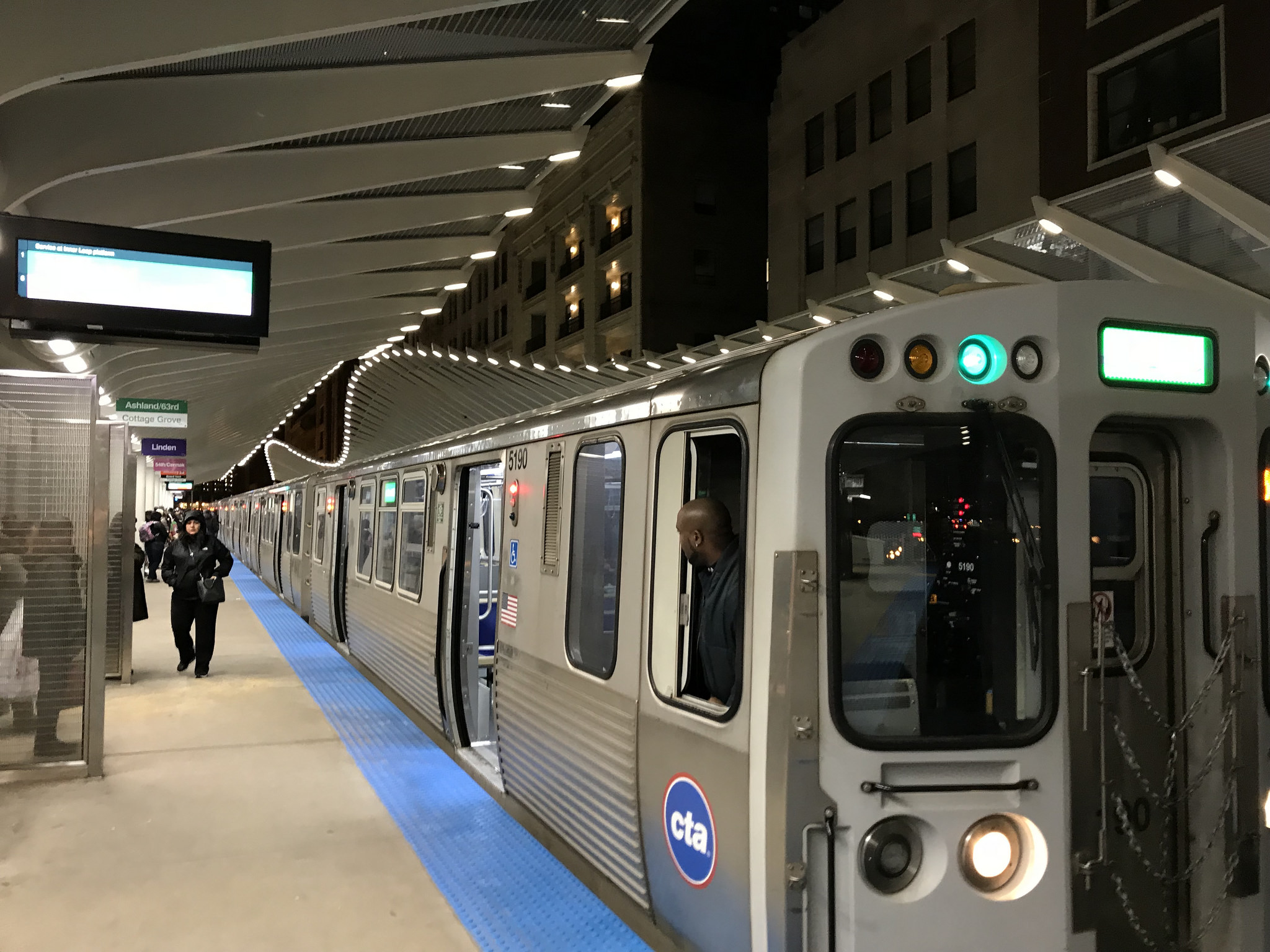In Spite of Everything, 2017 Was a Good Year for Transportation
2:43 PM CST on January 4, 2018

The opening of the new Washington-Wabash ‘L’ station was a highlight of 2017. Photo: John Greenfield
[Streetsblog Chicago editor John Greenfield publishes a weekly transportation column in the Chicago Reader. We syndicate the column on Streetsblog after it comes out.]
When I wrote my 2016 Reader year-in-review in the wake of Donald Trump’s election and the Republican proposal to eliminate all federal grants for sustainable transportation, I predicted, “[2016] will likely have been the best transportation year Chicago sees for a while.”
Indeed, 2017 was a kidney stone of a year in many respects, wrapping up with the passage of Trump’s swamp-friendly tax bill, which will slash taxes for the wealthy and corporations while starving the federal government of revenue. So it’s likely that the GOP will try to follow through with their threat to gut funding for rail, pedestrian, and bike infrastructure in 2018. But for the moment, let’s comfort ourselves with the fact that 2017 was still a pretty good year for Chicago transportation, although it definitely had its ups and downs.
From a street safety perspective, the biggest news was the June release of the city’s long-awaited Vision Zero plan to eliminate all traffic deaths by 2026. But the program, which is currently focused on west side neighborhoods with high crash rates, soon sparked controversy as Slow Roll Chicago cofounder Oboi Reed called for eliminating the possibility of additional traffic policing in black and Latino communities. Reed also persuaded the Active Transportation Alliance to postpone its scheduled Vision Zero summit, arguing that its cost, location, and timing would discourage participation by west siders.
Meanwhile, five of Chicago’s seven on-street bike fatalities in 2017, up from six in 2016, took place on the west and near west sides. One case, the hit-and-run crash that killed Angelo Resto, 46, on the 3800 block of West August in Humboldt Park in December, is still unsolved. Local cyclists were also dismayed at the light sentence handed out in January 2017 to motorist Ryne San Hamel, who pled guilty to killing 26-year-old Groupon employee Bobby Cann on his bike in 2013 while drunk and speeding: a mere 10 days in jail.
One bright spot amidst these tragedies was City Council’s passage of an ordinance in July requiring truck safety mirrors and side guards – which help prevent pedestrians and cyclists from going under the wheels – on vehicles used by city contractors. The legislation, a response to four fatal truck-bike crashes in the region in 2016, should help save lives.
As for bike infrastructure, the Chicago Department of Transportation kept fairly busy in 2017, marking 21.6 miles of bikeways from Hegewisch to Edgewater. On the other hand, the west and southwest sides got almost nothing, save for some half-hearted protected bike lanes (the only PBLs built this year) on Polk in the Illinois Medical District and Loomis in Pilsen. The only protection from traffic offered by these bikeways is some sporadically placed plastic posts, and drivers are currently treating the curbside Polk lane like a parking lane.
Also annoying was the further delay of the $60 million-plus Navy Pier Flyover bike overpass project, which was already taking longer to complete than the Golden Gate Bridge. In October, CDOT acknowledged that it won’t be finished until mid 2019, half a year behind schedule.
Still, plenty of good bikeways debuted in 2017. In May CDOT opened the $65,000 Glenwood Greenway, legalizing two-way cycling on an already popular route through Uptown and Edgewater. Over the summer the department did a $253,000 makeover of the Milwaukee Avenue “Hipster Highway” corridor in Wicker Park / Bucktown, including experimental “dashed bike lanes” on the tight stretch between North and Division. The project also redesigned the chaotic North/Damen/Milwaukee “Crotch,” setting aside more space for people walking and biking.
In August the Forest Preserve District of Cook County completed a $7.7 million extension of the North Branch Trail four-miles further southeast into the city, making it easier for urbanites to pedal to the Chicago Botanic Gardens in Glencoe. Thanks to a $12 million gift from Republican hedge fund billionaire Ken Griffin, the Chicago Park District made significant headway on building separate paths for pedestrians and cyclists on the Lakefront Trail, a project that’s slated for completion this year. It’s great that Griffin is using his vast wealth to do more than just help bankroll the dysfunctional Governor Bruce Rauner regime.
September was the 20th anniversary of Chicago’s monthly Critical Mass bike parade and protest, which Active Trans recently credited with helping to shift our city’s cycling revolution to a higher gear.
And a new game-changer may be in the works as purveyors of dockless bike-sharing technology – which does away with costly stations and lets users locate and check out bikes via smartphone – began courting City Hall in late 2017. While some local bike advocates worry that venture capital-backed dockless bikes could cause street clutter and cannibalize Divvy revenue, others hope that the tech would bring shared bikes to underserved communities that may not get Divvy stations for years.
At the same time, there was a growing awareness in Chicago that new transportation amenities such as multiuse trails and CTA-friendly high-rises can be a double-edged sword in gentrifying communities. Affordable housing activists in Logan Square continued to protest the construction of upscale, parking-lite, transit-oriented development towers, which they argue are accelerating the displacement of longtime residents. And, in response to steeply rising home prices along the Bloomingdale Trail in Logan and Humboldt Park, in May housing advocates and aldermen proposed the 606 affordability ordinance, which would charge developers hefty fees for building teardowns and expansions and use the revenue to fund low-cost housing.
Another initiative that could boost equity is the new tax on ride-hailing trips that City Council passed in November. Since the fee is projected to raise millions of dollars for CTA infrastructure, it should help level the playing field for Chicagoans who can’t afford Uber and Lyft. On the other hand, faced with budget shortfalls partly due to state budget cuts, all three local transit systems are raising ticket prices in 2018, including a 25-cent CTA fare hike that kicks in on January 8.
2017 was a good year for new CTA stations, with the August debut of the $75 million, Calatrava-inspired Washington-Wabash el stop in the Loop. I’m a fan of its graceful, undulating form, reminiscent of a whale’s skeleton. The $203 million Wilson station reconstruction in Uptown, is also coming along nicely and should be finished this month. The rehab turned the stop into a Red-Purple transfer, added elevators and a dazzling installation by U.K. artist Cecil Balmond, and is restoring the 1923 Gerber Building, on the north side of Wilson, to its former glory. Meanwhile, the $280 million renovation of 95th Street Red Line station, including artwork by Chicago favorite son Theater Gates, is rolling along and should wrap up by the end of this year.
There was transit news of a more dubious sort in November, when Mayor Rahm Emanuel announced a request for qualifications for a concessionaire to finance, build, and run his pet project, the O’Hare Express luxury transit line. Local transportation experts questioned whether the upscale initiative represents a wise or fair use of city planning resources, but tech guru Elon Musk immediately tweeted his intention of digging a tunnel to shoot travelers to the airport in “electric pods.” However, at a recent artificial intelligence conference Musk stated that public transportation “sucks,” partly because “there’s like a bunch of random strangers, one of who might be a serial killer,” which calls into question whether he’s the right person for the O’Hare Express gig.
At any rate, here’s wishing you a safe, efficient, and vibrant 2018, and may all your CTA rides be free of serial killers.
In addition to editing Streetsblog Chicago, John writes about transportation and other topics for additional local publications. A Chicagoan since 1989, he enjoys exploring the city on foot, bike, bus, and 'L' train.
Read More:
Stay in touch
Sign up for our free newsletter
More from Streetsblog Chicago
One agency to rule them all: Advocates are cautiously optimistic about proposed bill to combine the 4 Chicago area transit bureaus
The Active Transportation Alliance, Commuters Take Action, and Equiticity weigh in on the proposed legislation.
State legislators pushing for merging CTA, Pace, and Metra into one agency spoke at Transit Town Hall
State Sen. Ram Villivalam, (D-8th) and state Rep. Eva-Dina Delgado (D-3rd), as well as Graciela Guzmán, a Democratic senate nominee, addressed the crowd of transit advocates.



